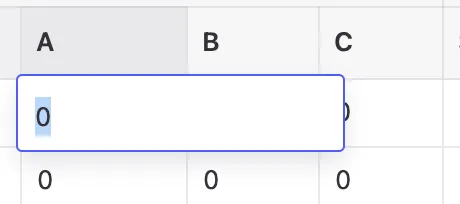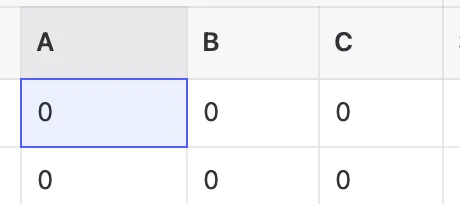Frequently Asked Questions
How do I get rid of the watermark?
By purchasing a premium pass. A premium pass removes the watermark, enables unlimited downloads, and allows downloading the plot as an SVG file.
Purchasing a pass helps keep this place running and support development.
Unauthorized removal off the watermark may result in a lifetime ban.
What does making an account do?
Making an account is required for purchasing a premium pass.
How do I quickly enter data?
Uploading a CSV file
You can upload a CSV file using the upload button above the table, or by dragging and dropping a CSV file onto the table. See “Uploading data” in the documentation on how to correctly format your file.
Pasting data
You can paste values directly into multiple data cells at once from Excel or Google Sheets. You can also copy plain text as long as the values are separated by tabs.
- First, select and copy multiple cells in Excel/Google sheets.
- In the table, select the first cell you want to copy in to. Make sure the cell is only selected and not being edited.

A table cell in edit mode 
A table cell that is selected - Paste when the cell is selected and not in edit mode, multiple cells will be set at once.
Note that the cell values are validated on paste. A warning will be displayed for each invalid value.
How do I add text to the plot?
Text can be added to the plot by entering values in the text table. Like points, text needs ternary coordinates (A, B, C values) to determine its position on the plot. You can use the crosshair tool to find the exact ternary coordinates for where you want to place the text - click on a location on the plot and the crosshair will show you the corresponding A, B, C values.
You can nudge the text around by adding x- and y-offsets to a text entry.
How do I add a legend?
See the Legend docsClick the button in the toolbar above the plot. Now you can now add items to the legend by clicking on items in the ternary plot. Press the legend item text to change it. Press the trash icon to the right of the item to remove it.
How do I make a USDA Soil Triangle, Folk QFR Diagram or Dickinson QFL chart?
See the Templates docs.Press the “Templates” button in the toolbar in the right pane. This will open a templates dialog where you can select your template. It includes a button to hide the labels of the template as well.
I have entered data but I don’t see anything on the plot?
In case the plot doesn’t show what you are expecting, check the following:
- Check if the element has ternary values i.e. the values are not (0, 0, 0).
- Check if all the plot elements are toggled in the toolbar above the plot. Blue means enabled, gray means disabled.
- Check if the fill and/or stroke color of the elements is the not same as the background color.
- Check if the opacity of the elements is not 0.
- Check if your color format has a opacity (alpha) channel that is set to 0%, for example
hsla(77 100% 50% / 0)
I need to edit only certain settings of the plot, how do I do that?
See the Configuration docs.You can configure many features of the plot in the configuration menu. The configuration menu is opened by pressing the button with the gear icon in the right corner of toolbar above the plot.
You can plot text and nudge it around using the offset properties. However if you need to add annotations outside of the plot, it easier to download to the plot as an SVG and add the annotions in vector editing software like Inkscape, Illustrator, or Figma.
I need some feature but TernaryPlot.com does not have it. What do I do now?
TernaryPlot.com aims to be comprehensive enough for most users. I want to strike a balance between an intuitive user interface and number of features. That’s why this app does not support every possible feature.
You can download the plot as an SVG and open it in an SVG editing software like Inkscape, Illustrator, or Figma.
Or check out one of the following software libraries for creating ternary plots:
- R language
- ggtern
- Ternary
- vcd
- Python
- mpltern
- python-ternary
- Pyrolite (geochemistry)
- PyGMT
- JavaScript
- Observable Plot
- d3 with d3-ternary
Points
I have entered data for a point but it is not showing in the plot.
- Check if the points size is not set to 0.
- Also check if its opacity is not set to 0.
I have so many points plotted close to each other that I can’t distinguish them.
In case of overplotting, here’s what you can do.
- Change the domains to focus on a specific region.
- Decrease the size of the points.
- Decrease the opacity of the points.
- Make only the most interesting points larger and make the rest of the points much smaller or more transparent.
- Add the most interesting points last in the table. The points are plotted in order, meaning later points are plotted on top of previous points.
Config
Why doesn’t the plot show the number of ticks or gridlines I have entered?
The axes are smart in choosing a number of gridlines and ticks. The entered number is a suggested count for the number per axis.
How can I change the domains? How can I zoom in to a part of the plot?
You can change the domains in two ways to focus on specific regions of the plot:
- Using the “Domains” section in the configuration menu (gear icon):
- Click the “View domains” button to see the current domain area
- Use the “Domain length” slider to zoom in/out (values less than 1 zoom in)
- Click and drag the shaded triangle to position it over your area of interest
- Use number inputs to precisely set domain boundaries for each axis if needed
- Click “Confirm domains” when satisfied
- Using the quick controls above the plot:
- Click the “View domains” button
- Use the slider to change the domain length
- Click and drag the shaded triangle to position it
- Click “Confirm domains” when satisfied
The domain values snap to the nearest 1% for precision. The shaded area shows the current visible region of the plot.
See the Custom Partial Domains documentation for more details on focusing on specific regions.
How can I reverse the domains?
You can reverse the domains using the “Reverse domains” toggle in the Domains section of the configuration menu (gear icon). This will flip the direction of all axes and automatically adjust the label and tick angles accordingly.
How do I create a line connecting my points?
There are two ways to connect points with lines:
- Click the “Connect Line” button in the Interaction menu above the plot. Now press the points you want to connect in the order you want them to be connected.
- In the table, select and copy the points that form the line from the points table to the lines table. Reorder them if needed.
You can style the lines by changing their color, width, and dash pattern in the Lines table. See the Lines documentation for more details.
Question not in the list?
Well, ask it here: